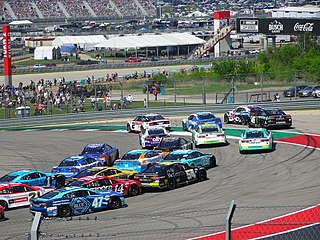
Auto racing is a motorsport involving the racing of automobiles for competition.

Drag racing is a type of motor racing in which automobiles or motorcycles compete, usually two at a time, to be first to cross a set finish line. The race follows a short, straight course from a standing start over a measured distance, most commonly 1⁄4 mi, with a shorter, 1,000 ft distance becoming increasingly popular, as it has become the standard for Top Fuel dragsters and Funny Cars, where some major bracket races and other sanctioning bodies have adopted it as the standard. The 1⁄8 mi is also popular in some circles. Electronic timing and speed sensing systems have been used to record race results since the 1960s.

The National Hot Rod Association (NHRA) is a governing body which sets rules in drag racing and hosts events all over the United States and Canada. With over 40,000 drivers in its rosters, the NHRA claims to be the largest motorsports sanctioning body in the world.
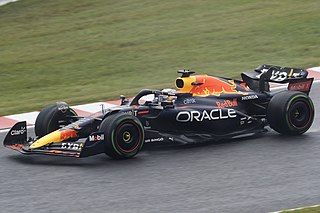
Motorsport, motorsports or autosports is a global term used to encompass the group of competitive sporting events which primarily involve the use of motorized vehicles. The terminology can also be used to describe forms of competition of two-wheeled motorised vehicles under the banner of motorcycle racing, and includes off-road racing such as motocross.

Supermoto is a form of motorcycle racing held on race tracks that alternate between three kinds of track surfaces: the hard packed dirt of flat track, the irregular jumps and obstacles of motocross, and the paved tarmac of road racing. Supermoto was originally conceived by Gavin Trippe in 1979 as a segment of the TV show Wide World of Sports. It was something like an all-star game, in which the best riders from the three separate genres of motorcycle racing could temporarily leave their normal race class to come together and compete for the title of best all around racer. Today supermoto is a distinct genre of its own and riders in the other classes do not routinely cross over into supermoto.

Road racing is a form of motorsport racing held on a paved road surface. The races can be held either on a closed circuit or on a street circuit utilizing temporarily closed public roads. Originally, road races were held almost entirely on public roads. However, public safety concerns eventually led to most races being held on purpose-built racing circuits.
Cycle sport is competitive physical activity using bicycles. There are several categories of bicycle racing including road bicycle racing, cyclo-cross, mountain bike racing, track cycling, BMX, and cycle speedway. Non-racing cycling sports include artistic cycling, cycle polo, freestyle BMX and mountain bike trials. The Union Cycliste Internationale (UCI) is the world governing body for cycling and international competitive cycling events. The International Human Powered Vehicle Association is the governing body for human-powered vehicles that imposes far fewer restrictions on their design than does the UCI. The UltraMarathon Cycling Association is the governing body for many ultra-distance cycling races.
Dirt track racing is a form of motorsport held on clay or dirt surfaced oval race tracks often used for thoroughbred horse racing. Dirt track racing started in the United States before World War I and became widespread during the 1920s and 1930s using both automobiles and motorcycles. Two different types of race cars dominate — open wheel racers in the Northeast and West and stock cars in the Midwest and South. While open wheel race cars are purpose-built racing vehicles, stock cars can be either purpose-built race cars or street vehicles that have been modified to varying degrees. There are hundreds of local and regional racetracks throughout the nation. The sport is also popular in Australia, New Zealand, Canada, South Africa and the United Kingdom.

The Circuit de Charade, also known as Circuit Louis Rosier and Circuit Clermont-Ferrand, is a motorsport race track in Saint-Genès-Champanelle near Clermont-Ferrand in the Puy-de-Dôme department in Auvergne in central France. The circuit, built around the base of an extinct volcano, was known for its challenging layout which favored the most skillful drivers and motorcyclists. It hosted the French Grand Prix four times and the French motorcycle Grand Prix ten times.
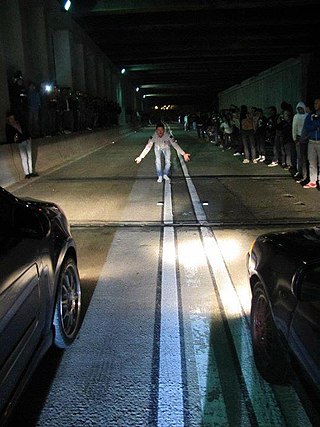
Street racing is typically an unsanctioned and illegal form of auto racing that occurs on a public road. Racing in the streets is considered an ancient hazard, as horse racing occurred on streets for centuries, and street racing in automobiles is likely as old as the automobile itself. It became especially prevalent during the heyday of hot rodding (60s), muscle cars (70s), Japanese imports (90s), and sports cars (2000s). Since then, it continues to be both popular and hazardous, with deaths of bystanders, passengers, and drivers occurring every year. In the United States, modern street racing traces its roots back to Woodward Avenue, Michigan, in the 1960s when the three main Detroit-based American car companies were producing high-powered performance cars. Since a private racing venue was not always available, street races would be held illegally on public roads.

Racing flags are traditionally used in auto racing and similar motorsports to indicate track conditions and to communicate important messages to drivers. Typically, the starter, sometimes the grand marshal of a race, waves the flags atop a flag stand near the start/finish line. Track marshals are also stationed at observation posts along the race track in order to communicate both local and course-wide conditions to drivers. Alternatively, some race tracks employ lights to supplement the primary flag at the start/finish line.
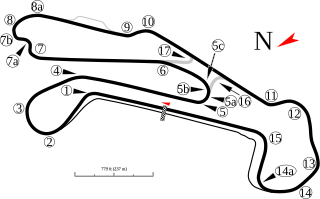
Barber Motorsports Park is an 880 acres (360 ha) multi-purpose racing facility located in Birmingham, Alabama. It was built by George W. Barber, and includes the 230,000-square-foot (21,000 m2) Barber Vintage Motorsport Museum. It has been the site of the IndyCar Series' Grand Prix of Alabama since 2010. The Annual Barber Vintage Festival has taken place at the park each October since 2005. Barber Motorsports Park is also the home of the Porsche Track Experience.
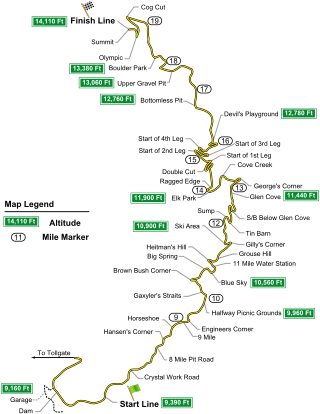
The Pikes Peak International Hill Climb (PPIHC), also known as The Race to the Clouds, is an annual automobile hillclimb to the summit of Pikes Peak in Colorado, USA. The track measures 12.42 miles (19.99 km) and has over 156 turns, climbing 4,720 ft (1,440 m) from the start at Mile 7 on Pikes Peak Highway, to the finish at 14,115 ft (4,302 m), on grades averaging 7.2%. It used to consist of both gravel and paved sections, but as of August 2011, the highway is fully paved; as a result, all subsequent events will be run on asphalt from start to finish.

Motorsport marshals are mainly volunteer workers responsible for the safety of motor racing competitors. They are stationed at various points of danger around race tracks to assist them in case of any collisions, accidents or track problems. Marshals are also known as course workers, corner workers, corner crews, turn marshals, corner marshals, track safety workers, or rally marshals.

The motorcycle sport of racing includes motorcycle road racing and off-road racing, both either on circuits or open courses, and track racing. Other categories include hill climbs, drag racing and land speed record trials.
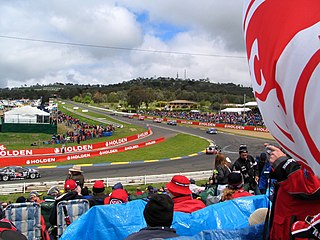
Motorsport is a popular spectator sport in Australia, although there are relatively few competitors compared to other sports due to the high costs of competing. The oldest motorsport competition in Australia is the Alpine Rally which was first staged in 1921 followed by the Australian Grand Prix, first staged in 1928. The most widely watched motorsport category is Supercars, especially at the Bathurst 1000. Other classes in Australia include Australian GT, Formula 3 and Formula Ford, Superbikes, as well as various forms of speedway racing.
The Championship Cup Series (CCS) is an American motorcycle racing sanctioning body. The American Sportbike Racing Association LLC (ASRA) is the parent company of CCS.

Gainesville Raceway is a quarter-mile dragstrip just outside Gainesville, Florida. It opened in 1969 and is most famous for hosting the NHRA's prestigious Gatornationals event since 1970. Kenny Bernstein became the first drag racer to break the 300 mile-per-hour barrier at the track on March 20, 1992, during qualifying for that year's Gatornationals.
The following is a glossary of terminology used in motorsport, along with explanations of their meanings.

NOLA Motorsports Park is a full service motorsports facility in Avondale, Louisiana approximately twenty minutes from downtown New Orleans. NOLA Motorsports Park includes an FIA Grade 2 road course, one of the largest (fully-lit) outdoor karting tracks in the country, and a 300,000 square ft. soft-grade asphalt skid pad, perfect for drifting and autocross.
















